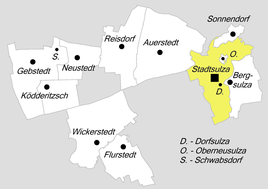Village sulza
|
Village sulza
Rural community of Bad Sulza
Coordinates: 51 ° 5 '17 " N , 11 ° 37' 43" E
|
|
|---|---|
| Incorporation : | 1907 |
| Postal code : | 99518 |
| Area code : | 036461 |
|
Location of the district in the rural community Bad Sulza
|
|
|
Johanneskirche in Dorfsulza
|
|
Village Sulza is part of the core city of the rural community of town Bad Sulza in the district Weimarer Land in Thuringia .
geography
Dorfsulza is located east of the Ilm and the Erfurt - Halle - Leipzig railway line in the valley and on the rise of the south- eastern slope to the hill around Schmiedehausen . The main road in 2156 (former Salt Road) runs through the Ilmaue and then begins a steep ascent and curvaceous front mountain Sulza .
history
The village was mentioned for the first time in 1512 in the inheritance book of the governor of Niederroßla . Since the middle of the 15th century, the place belonged to the Wettin from 1485 Ernestine Office Roßla , which in 1572 to Saxe-Weimar , 1603 to Saxe-Altenburg , 1672 again to Saxe-Weimar and 1741 to Saxe-Weimar-Eisenach . During the administrative reform of the Grand Duchy of Saxony-Weimar-Eisenach, the place came to the administrative district Weimar II ( administrative district Apolda ) in 1850 . In 1907 the town of Sulza and the village of Sulza were combined to form the town of Bad Sulza.
Until the Reformation, Dorfsulza, also just called "Sulza" (in contrast to Stadtsulza / Sulza oppidum and Bergsulza / monte Sulza) had its own parish church. This was dedicated to Saint Wigbert. In the local literature this is wrongly referred to Bergsulza. According to the Evangelical Lutheran doctrine, the church continued to have no name of saints. Until 1926 the church was a branch of Stadtsulza and was then handed over to the newly founded Catholic community. This consecrated the church in the name of St. John Evangelista . The mention of a St. Mary's Church in 1293, which is mentioned several times, cannot be proven.
Dorfsulza is characterized by guest care and hospitality. The favorable location of the Ilmaue and wooded slopes influences the cultivation of fruit and horticultural crops, which in turn affects the closeness to nature. The train station and the spa facilities also have a positive effect on village life in the city.
literature
- Horst MF Heyland: History of Bergsulza and Dorfsulza (= Bergsulza. Building blocks for the history of our homeland. Vol. 2 = Bad Sulzaer Heimathefte. 11, ZDB -ID 2290657-5 ). HMF Heyland, Leutkirch im Allgäu 1998.
Web links
Individual evidence
- ↑ Hereditary book of the clerk Roßla from the year 1512. In: Georg Judersleben: Inhabitants of Sulza before the Reformation (= Bad Sulzaer Heimathefte. 1). Frauendorff, Bad Sulza 1936, pp. 42–47.
- ^ Ortschronik on the website of the city of Bad Sulza. Queryed March 6, 2012.
- ↑ Martin Hannappel: The area of the Archidiakonates Beatae Mariae Virginis Erfurt at the end of the Middle Ages. A contribution to the ecclesiastical topography of Thuringia (= work on regional and folk research. 10, ZDB -ID 985325-x ). G. Fischer, Jena 1941, (at the same time: Jena, University, dissertation, from December 6, 1941).


